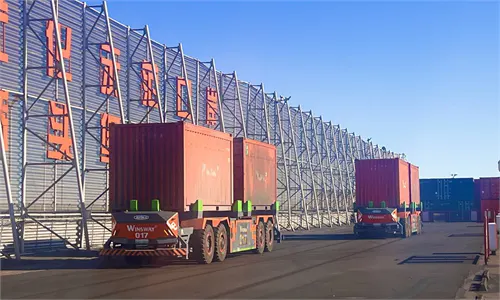Along the 1.86-kilometer route connecting Chinese and Mongolian stockyards, several autonomous driving trucks are operating back and forth between coal terminals, one of the most-traded commodities between the two countries.
The trucks have been running for nearly 16 months since China’s first Auto Guided Vehicle (AGV) cross-border transport system for land port entered operation at Ganqmod Port in North China’s Inner Mongolia Autonomous Region, the largest highway port on the China-Mongolia border.
“The maximum speed of AGV can reach 25 kilometers per hour, and can complete a round trip between two stockyards in 50 minutes,” GaoMingyue, general manager for AGV central control of E-commodities Holdings Limited (E-comm), told the Global Times over the weekend.
E-comm, the operator of the AGV transport system, has a total of 30 AGVs, and deploys 24 AGVs on weekdays.
The Mongolian side also has 30 AGVs, with an annual transport capacity estimated to be near 15 million tons if all 60 AGVs are in use.
The automatic transport system has boosted the efficiency of transport between China and Mongolia. “Each lorry can load with at most four standard containers and makes four to six round trips each month, and a single AGV loading with two standard containers can make six to seven round trips each day,” Gao noted.
The AGV transport system has been applied across multiple Chinese land and sea ports for nearly two decades, but this is the first time it has been fully integrated into a land port, the Global Times learned, with the system also deployed at the border port of Ceke, another land port in the northern Chinese region bordering Mongolia.
Ganqmod Port is a major energy import channel for China and Mongolia with a focus on the coal trade, and also acts as an important hub for the China-Mongolia-Russia economic corridor.
As of Monday, the port had handled 31.73 million tons of cargo this year alone, up 119.16 percent year-on-year, becoming China’s largest port for importing Mongolian coal and copper powder, data from the port administration showed.
To improve communications between the two sides, the port recently resumed two-way passenger traffic on Monday after more than three years of suspension during the pandemic, signifying that all land ports in the region have resumed cross-border passenger clearance.
According to local customs data, a total of 91 passengers passed through the clearing area on the first day of resumption. In 2019, the port facilitated 183,695 cross-border passengers from both sides.
Before the resumption of passenger clearance, Mongolian personnel had to enter China for business and wholesale purchases via Manzhouli or Erenhot Port, which are China’s largest trade hubs with Russia and Mongolia respectively.
Border advantages
Situated in the north of China, bordering eight provinces in the country as well as Russia and Mongolia, Inner Mongolia Autonomous Region has become a major bridgehead in the nation’s push for opening up in the northern area.
Taking advantage of its significant port cities both on the highway and railway routes, the autonomous region is seeing more economic and trade connections with neighboring Mongolia and Russia, the two of which accounts for more than half of Inner Mongolia’s import export trade as well as a considerable share of China’s trade with both countries.
Taking Ganqmod Port as an example, it has grown robustly to a major connection hub for the China-proposed Belt and Road Initiative (BRI), Mongolia’s “Steppe Road Program” development strategy and the China-Mongolia-Russia economic corridor, UlziikhutagBayanmunkh, chairman of the Border Ports Administration, Mongolian Umnugobi Province, told the Global Times when visiting the port. In the wake of the development of the BRI, foreign trade in Ceke Port, located at Ejin Banner, has set new records for trade activity this year, reaching 14.82 million tons, worth 9.78 billion yuan ($1.34 billion), the highest level since the port was opened 31 years ago, the Global Times learnt from local customs officials.










